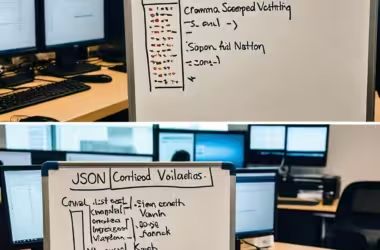In the realm of software design, writing clean code is key. Robert C. Martin, a well-known author, supports this. He believes clean code shows developers’ commitment to quality. The SOLID Principles guide improving code quality. These are five core concepts every developer should know.
They include the Single Responsibility Principle, Open/Closed Principle, Liskov Substitution Principle, Interface Segregation Principle, and Dependency Inversion Principle. Knowing and using these principles helps make code easier to manage and grow. This is crucial for good object-oriented design.
What Are the SOLID Principles?
The SOLID principles offer a key to great software engineering, especially for designs using objects. They were introduced by Robert C. Martin in 2000, and Michael Feathers named them. Together, these principles make software structure better.
- Single Responsibility Principle (SRP): A class should only have one reason to change. This avoids complications from mixing different tasks. For example, it’s a mistake to have printing, saving, and business rules all in one class.
- Open/Closed Principle (OCP): Software pieces should be easy to extend but not change. It suggests using interfaces and abstract classes to add new features without changing old code.
- Liskov Substitution Principle (LSP): Objects in a program should be replaceable with instances of their subtypes without disrupting the program. This makes the program more flexible.
- Interface Segregation Principle (ISP): Don’t force clients to rely on interfaces they don’t need. It’s better to have specific interfaces that meet the exact needs, improving system design.
- Dependency Inversion Principle (DIP): High-level parts shouldn’t depend on low-level parts. Instead, both should depend on abstractions. This helps in making testing and maintaining software easier.
Following the SOLID principles helps developers build software that’s easier to maintain, scale, and more reliable. This greatly improves the quality of object-oriented design.
The Importance of Clean Code
Clean code is key in software development. It’s vital for making code easy to read, keep up, and depend on. Parts like formatted consistently and clear naming help people understand the code better. This lets developers work more effectively.
Following the SOLID principles helps maintain clean code. These principles guide the structure and function of software. For instance, the Single Responsibility Principle says a class should only have one job. This makes the code easier to read and maintain.
Using the Open/Closed Principle, developers can add new features without changing old code. This keeps the software reliable. Designing classes this way reduces the risk of new bugs. It also sets clear standards that make working together easier.
- Encourages better code readability.
- Reduces the likelihood of bugs, promoting software reliability.
- Facilitates easier collaboration among developers.
- Enhances code maintainability and extensibility.
As projects grow, keeping code clean is more important. It means being proactive in software development. This approach keeps code strong and flexible as needs change. Sticking to clean code principles leads to higher quality software. It makes development more enjoyable and successful in the long run.
Single Responsibility Principle
The Single Responsibility Principle (SRP) tells us that a class should only have one reason to change. It’s about organizing code well so each class does just one specific thing. By sticking to the SRP, developers make their code clearer and easier to keep up, cutting down on unexpected bugs as things change.
Definition and Significance
SRP makes class jobs simpler. When a class tries to do too much, it gets hard to deal with. Imagine a class that handles both student sign-ups and sending emails. It mixes things that should be separate and gets too bulky to manage easily. A class that started with about 2000 lines of code shows how messy this can get.
After applying SRP and splitting tasks into classes like StudentRegister, StudentResult, and StudentEmails, things got much better. Now, each class has just one job. This leads to a neater setup and code that’s easier to handle.
Practical Examples
Many real-world examples show why SRP matters. Take the Java Persistence API (JPA), which makes managing data in databases consistent. Its EntityManager handles entities in one clear-cut role. The Spring Data repository is another good case. It does the repository pattern, doing common tasks like create, update, remove, and read, which helps keep code well-organized.
By using the Single Responsibility Principle, developers get code that’s simpler to test, grow, and comprehend. So, software built with SRP faces fewer issues and can be developed faster. Ultimately, SRP makes team work smoother and adapting to new needs easier.
Open/Closed Principle
The Open/Closed Principle (OCP) is a core rule in the SOLID principles of software design, created by Bertrand Meyer in 1988. It means software should be easy to extend but not change. In short, we want to add new things without messing up what already works.
Understanding the Concept
OCP aims to make software easy to grow. It helps code stay tough and flexible. For instance, think of a simple coffee machine in code. Developers can add more types of coffee machines without breaking the original design. This approach values interfaces for high-level planning and smooth additions.
Real-world Applications
In real life, the Open/Closed Principle is everywhere. Like in software that handles various coffee machines. A more advanced coffee machine class can add new features without affecting the old ones. This method keeps the system easy to upgrade. Following OCP helps code stay clean, easy to manage, and less buggy. Studies show sticking to OCP makes software more stable.
Liskov Substitution Principle
Introduced in 1987 by Barbara Liskov, the Liskov Substitution Principle (LSP) highlights a key concept. It states that objects of a superclass should be replaceable by objects of a subclass. Such replacement should not affect the program’s correctness. This principle ensures that inheritance in object-oriented programming (OOP) works effectively.
When subclasses extend the functionalities of their superclass properly, they maintain the system’s reliability. They keep the intended behavior of the original class intact.
LSP is about behavioral subtyping, which has rules inherited classes must follow. For instance, the types of method parameters must support contravariance. Method return types should allow covariance. And, exceptions thrown by methods must meet certain constraints. LSP also sets rules on preconditions, postconditions, invariants, and a history constraint to protect program integrity.
Following LSP boosts code reusability and modularity. It lets developers substitute derived classes for base classes easily. This supports polymorphism, enabling interchangeable object use based on their shared base class. By adhering to LSP, programs strengthen their abstraction layers and interface contracts. This ensures that derived classes meet the expectations set by their base classes.
Applying the LSP to your code makes it more maintainable and flexible. It helps reduce repetition, simplify the structure, and permits changes to derived classes without altering original code. LSP underlines the importance of clear class contracts through Design by Contract. Such contracts define expected behaviors and guarantees, crucial for reliable software development.
Let’s look at practical applications of LSP for a clearer understanding. Take a Java program with a superclass Bird and subclasses Duck and Ostrich. Here, Duck extends FlyingBird, which includes the fly method. This approach follows LSP by preventing method conflicts. On the other hand, making a Square inherit from a Rectangle could violate LSP. This could lead to conflicting methods and constraints, causing unpredictable behavior. Understanding LSP in practice helps developers write strong, error-free code.
Interface Segregation Principle
The Interface Segregation Principle (ISP) is a key part of the SOLID design principles by Robert C. Martin. It focuses on making interfaces precise and to the point. With ISP, we ensure that no client relies on methods it doesn’t need. This approach leads to a modular design that’s easier to maintain. It makes responsibilities clear, lessens side effects, and reduces the need to adjust software.
Benefits of ISP
ISP brings several benefits to software development:
- It bolsters a modular design, letting developers create classes that need only certain interfaces.
- It cuts down on large, confusing interfaces that can cause issues.
- Functions become more independent, so changes don’t affect unrelated parts.
- Code becomes simpler to read, which eases maintenance work.
Examples of Interface Design
Let’s look at how ISP works with printers. Often, a single Printer interface includes all possible functions like printing, scanning, and faxing. But a basic printer that only prints shouldn’t have to deal with scanning or faxing. This just makes things too complicated. Having separate interfaces for Printer, Scanner, and Fax means each device does only what it needs. This keeps the code clean and easy to handle.
Take coffee machines as another example. Different machines have different brewing methods. Separating these functions means no machine has to carry pointless, unused methods. With ISP, designs are more streamlined and focused. It strengthens the idea of a modular design.
Dependency Inversion Principle
The Dependency Inversion Principle, or DIP, is key in object-oriented design. It says high-level parts shouldn’t depend on low-level parts. Both should use abstractions. This helps create systems that are flexible and easy to change.
Using DIP, developers can keep the main logic apart from low-level details. Look at a CoffeeMachine project for example. By using interfaces like FilterCoffeeMachine and EspressoMachine, different coffee machines can work together smoothly. This makes the system easier to take care of and less likely to have errors.
If a budget report system only works with one kind of database, it’s not following DIP. Changing to another database, like MongoDB, would be hard. But, by using something like DatabaseInterface, changing databases becomes easier. This way, the software is more flexible.
In short, sticking to DIP leads to systems that are easy to manage and test. It makes the software better as it grows. The benefit is a high-quality, adaptable software.
Best Practices for Implementing SOLID Principles
To use the best practices SOLID principles well, developers need to focus on good software design. They should make detailed design plans. Each class and interface must have clear duties. This makes the code easy to read and maintain.
Using well-known design patterns helps follow these principles too. Patterns like Factory, Strategy, and Decorator make software modular and easy to extend. They keep each part of the software focused on its job. This supports the core ideas of SOLID principles.
Regular code reviews are also key. They help find any SOLID principle issues early on. Adding unit testing makes the code more reliable. It helps find problems concerning the five SOLID principles: Single Responsibility Principle, Open-Closed Principle, Liskov Substitution Principle, Interface Segregation Principle, and Dependency Inversion Principle.
Following these tips helps developers create strong, well-designed software. It aligns with both best practices SOLID principles and solid software design.
Common Pitfalls to Avoid
SOLID principles help in making code better. But, applying them can be tricky. Missteps lead to code issues and lost benefits. Knowing common mistakes helps keep code clean.
One big mistake is not following the Single Responsibility Principle. It’s easy for classes to end up doing too much. This makes the code hard to handle. For example, a method like ComputeNerdClusters shouldn’t mix in debugging tasks. That makes the class’s purpose unclear and hard to maintain.
Not using interfaces correctly is another error. It affects the Interface Segregation Principle. Not sticking to it keeps the code from being flexible and reusable. When a single interface does too many things, the code gets messy and tough to manage.
Ignoring the Dependency Inversion Principle is also a problem. This principle says to keep high-level and low-level modules apart. Not doing so means code is too connected. This makes changing or scaling the code hard. A good separation of duties keeps the code maintainable.
To avoid these SOLID principle pitfalls, developers must be vigilant. Good design principles lead to stronger, more successful software projects.
Conclusion
The SOLID principles guide software development towards clean code. Clean code makes software easier to maintain and grow. Knowing these principles helps developers build strong systems that can change without breaking. For example, the Single Responsibility Principle focuses on small, focused classes. This makes it clear what each part does.
Interfaces play a key role in four of the SOLID principles. These are the Open/Closed Principle, Liskov Substitution Principle, Interface Segregation Principle, and Dependency Inversion Principle. They push for coding that is flexible and well-organized. Mark Seemann compares non-SOLID with SOLID coding to Duplo and Lego. He shows that well-defined classes make software easier to keep up and test.
Learning about SOLID principles does more than just improve coding skills. It also raises the quality of the software created. For more on these ideas, “Agile Principles, Patterns and Practices in C#” by Robert C. Martin and Micah Martin is a great read. By adopting these principles, software engineers grow professionally. They can produce software that’s easier to read, use, and change.






